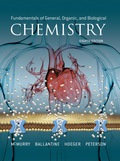
(a)
Interpretation:
The effect in the rate of an enzyme-catalysed reaction should be determined if temperature is raised from
Concept Introduction:
Enzyme:
- It is a protein or a molecule which can act as a catalyst for a biological reaction.
- Does not affect the equilibrium point of the reaction.
- Active site of the enzyme is the region where the reaction takes place.
- Enzyme’s activity can be specific which means the activity is limited to a certain substrate and a certain type of reaction and it is referred to as specificity of the enzyme.
Factors affecting enzyme activity:
Substrate concentration
Enzyme concentration
Temperature
(b)
Interpretation:
The effect in the rate of an enzyme-catalysed reaction should be determined if the
Concept Introduction:
Enzyme:
- It is a protein or a molecule which can act as a catalyst for a biological reaction.
- Does not affect the equilibrium point of the reaction.
- Active site of the enzyme is the region where the reaction takes place.
- Enzyme’s activity can be specific which means the activity is limited to a certain substrate and a certain type of reaction and it is referred to as specificity of the enzyme.
Factors affecting enzyme activity:
Substrate concentration
Enzyme concentration
Temperature
(c)
Interpretation:
The effect in the rate of an enzyme-catalysed reaction should be determined if an organic solvent like methanol is added.
Concept Introduction:
Enzyme:
- It is a protein or a molecule which can act as a catalyst for a biological reaction.
- Does not affect the equilibrium point of the reaction.
- Active site of the enzyme is the region where the reaction takes place.
- Enzyme’s activity can be specific which means the activity is limited to a certain substrate and a certain type of reaction and it is referred to as specificity of the enzyme.
Factors affecting enzyme activity:
Substrate concentration
Enzyme concentration
Temperature
Want to see the full answer?
Check out a sample textbook solution
Chapter 19 Solutions
EBK FUNDAMENTALS OF GENERAL, ORGANIC, A
- Which type of enzyme catalyses the following reaction? oxidoreductase, transferase, hydrolase, lyase, isomerase, or ligase.arrow_forward+NH+ CO₂ +P H₂N + ATP H₂N NH₂ +ADParrow_forwardWhich type of enzyme catalyses the following reaction? oxidoreductase, transferase, hydrolase, lyase, isomerase, or ligase.arrow_forward
- Which features of the curves in Figure 30-2 indicates that the enzyme is not consumed in the overall reaction? ES is lower in energy that E + S and EP is lower in energy than E + P. What does this tell you about the stability of ES versus E + S and EP versus E + P.arrow_forwardLooking at the figure 30-5 what intermolecular forces are present between the substrate and the enzyme and the substrate and cofactors.arrow_forwardprovide short answers to the followings Urgent!arrow_forward
- Pyruvate is accepted into the TCA cycle by a “feeder” reaction using the pyruvatedehydrogenase complex, resulting in acetyl-CoA and CO2. Provide a full mechanismfor this reaction utilizing the TPP cofactor. Include the roles of all cofactors.arrow_forwardB- Vitamins are converted readily into important metabolic cofactors. Deficiency inany one of them has serious side effects. a. The disease beriberi results from a vitamin B 1 (Thiamine) deficiency and ischaracterized by cardiac and neurological symptoms. One key diagnostic forthis disease is an increased level of pyruvate and α-ketoglutarate in thebloodstream. How does this vitamin deficiency lead to increased serumlevels of these factors? b. What would you expect the effect on the TCA intermediates for a patientsuffering from vitamin B 5 deficiency? c. What would you expect the effect on the TCA intermediates for a patientsuffering from vitamin B 2 /B 3 deficiency?arrow_forwardDraw the Krebs Cycle and show the entry points for the amino acids Alanine,Glutamic Acid, Asparagine, and Valine into the Krebs Cycle - (Draw the Mechanism). How many rounds of Krebs will be required to waste all Carbons of Glutamic Acidas CO2?arrow_forward
 Principles Of Radiographic Imaging: An Art And A ...Health & NutritionISBN:9781337711067Author:Richard R. Carlton, Arlene M. Adler, Vesna BalacPublisher:Cengage Learning
Principles Of Radiographic Imaging: An Art And A ...Health & NutritionISBN:9781337711067Author:Richard R. Carlton, Arlene M. Adler, Vesna BalacPublisher:Cengage Learning BiochemistryBiochemistryISBN:9781305577206Author:Reginald H. Garrett, Charles M. GrishamPublisher:Cengage Learning
BiochemistryBiochemistryISBN:9781305577206Author:Reginald H. Garrett, Charles M. GrishamPublisher:Cengage Learning Biology (MindTap Course List)BiologyISBN:9781337392938Author:Eldra Solomon, Charles Martin, Diana W. Martin, Linda R. BergPublisher:Cengage Learning
Biology (MindTap Course List)BiologyISBN:9781337392938Author:Eldra Solomon, Charles Martin, Diana W. Martin, Linda R. BergPublisher:Cengage Learning Biology: The Dynamic Science (MindTap Course List)BiologyISBN:9781305389892Author:Peter J. Russell, Paul E. Hertz, Beverly McMillanPublisher:Cengage Learning
Biology: The Dynamic Science (MindTap Course List)BiologyISBN:9781305389892Author:Peter J. Russell, Paul E. Hertz, Beverly McMillanPublisher:Cengage Learning Human Heredity: Principles and Issues (MindTap Co...BiologyISBN:9781305251052Author:Michael CummingsPublisher:Cengage Learning
Human Heredity: Principles and Issues (MindTap Co...BiologyISBN:9781305251052Author:Michael CummingsPublisher:Cengage Learning





